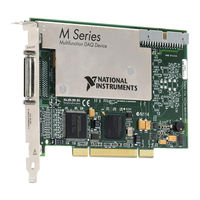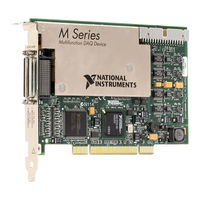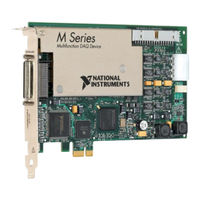National Instruments 625 Series Manuals
Manuals and User Guides for National Instruments 625 Series. We have 6 National Instruments 625 Series manuals available for free PDF download: User Manual
National Instruments 625 Series User Manual (298 pages)
Multifunction I/O Modules and Devices
Brand: National Instruments
|
Category: I/O Systems
|
Size: 5 MB
Table of Contents
-
Installation17
-
Unpacking17
-
Pinouts27
-
DAQ Hardware28
-
RTSI Cables33
-
Scxi34
-
RTSI Cables36
-
Scxi37
-
Scc38
-
LED Patterns46
-
Analog Input47
-
Digital I/O89
-
Static DIO90
Advertisement
National Instruments 625 Series User Manual (298 pages)
Multifunction I/O Modules and Devices
Brand: National Instruments
|
Category: I/O Systems
|
Size: 5 MB
Table of Contents
-
Installation17
-
Unpacking17
-
Pinouts27
-
DAQ Hardware28
-
RTSI Cables33
-
Scxi34
-
RTSI Cables36
-
Scxi37
-
Scc38
-
LED Patterns46
-
Analog Input47
-
Digital I/O89
-
Static DIO90
National Instruments 625 Series User Manual (298 pages)
Multifunction I/O Modules and Devices
Brand: National Instruments
|
Category: Data Loggers
|
Size: 5 MB
Table of Contents
-
Installation17
-
Unpacking17
-
Pinouts27
-
DAQ Hardware28
-
RTSI Cables33
-
Scxi34
-
RTSI Cables36
-
Scxi37
-
Scc38
-
LED Patterns46
-
Analog Input47
-
Digital I/O89
-
Static DIO90
Advertisement
National Instruments 625 Series User Manual (298 pages)
Brand: National Instruments
|
Category: I/O Systems
|
Size: 5 MB
Table of Contents
-
Installation17
-
Unpacking17
-
Pinouts27
-
DAQ Hardware28
-
RTSI Cables33
-
Scxi34
-
RTSI Cables36
-
Scxi37
-
Scc38
-
LED Patterns46
-
Analog Input47
-
Digital I/O89
-
Static DIO90
National Instruments 625 Series User Manual (298 pages)
Brand: National Instruments
|
Category: I/O Systems
|
Size: 5 MB
Table of Contents
-
Installation17
-
Unpacking17
-
Pinouts27
-
DAQ Hardware28
-
RTSI Cables33
-
Scxi34
-
RTSI Cables36
-
Scxi37
-
Scc38
-
LED Patterns46
-
Analog Input47
-
Digital I/O89
-
Static DIO90
National Instruments 625 Series User Manual (297 pages)
Multifunction I/O Modules and Devices
Brand: National Instruments
|
Category: I/O Systems
|
Size: 13 MB
Table of Contents
-
Installation16
-
Unpacking16
-
Pinouts26
-
DAQ Hardware27
-
RTSI Cables32
-
Scxi33
-
RTSI Cables35
-
Scxi36
-
Scc37
-
LED Patterns45
-
Analog Input46
-
Digital I/O88
-
Static DIO89





